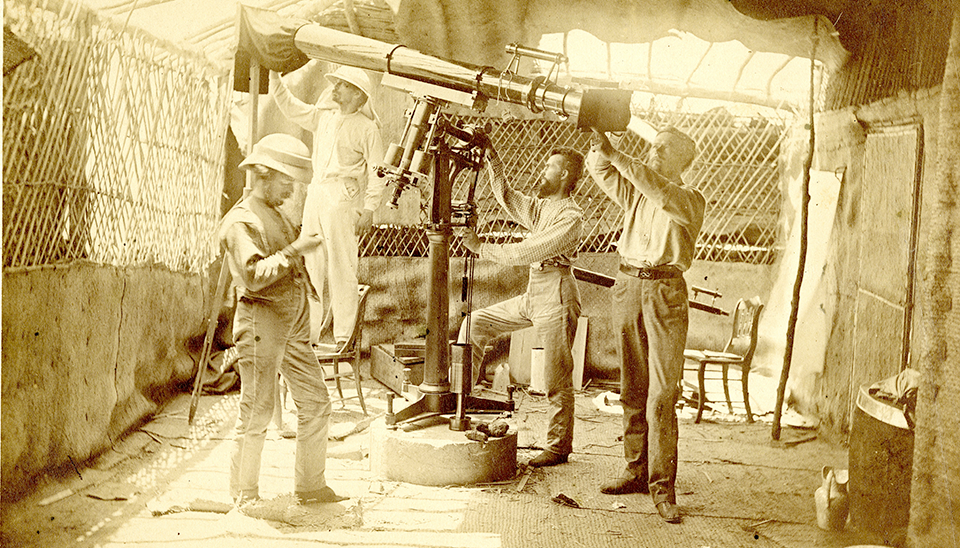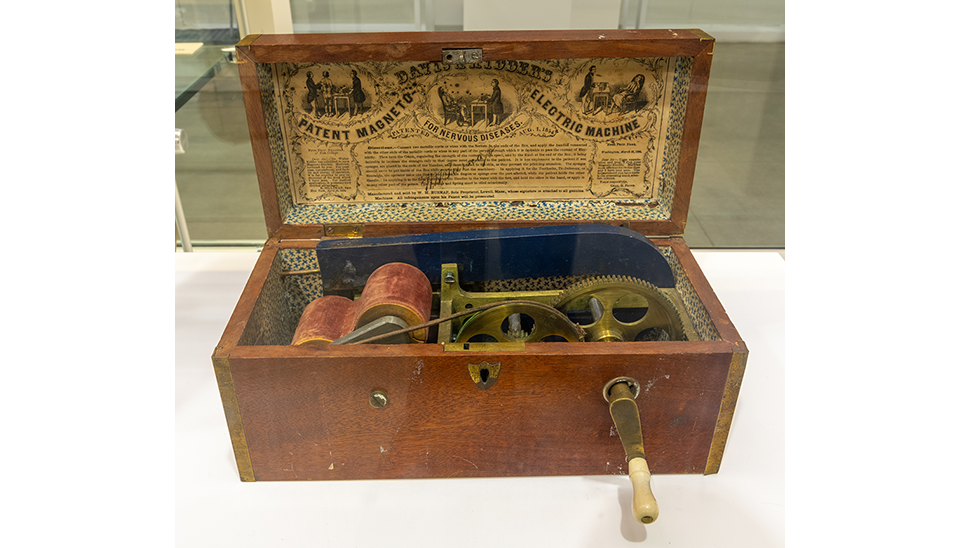Assistive hearing technology has come a long way since the early 20th century when the only hearing devices available were ear trumpets. Since the advent of electricity, innovations in hearing technology have greatly improved quality of life and communication for individuals with aural and speech disabilities. Better Hearing and Speech Month in May brings awareness to the risk of hearing injuries for civilians and service members and provides a forum to discuss prevention, diagnosis, and treatment.
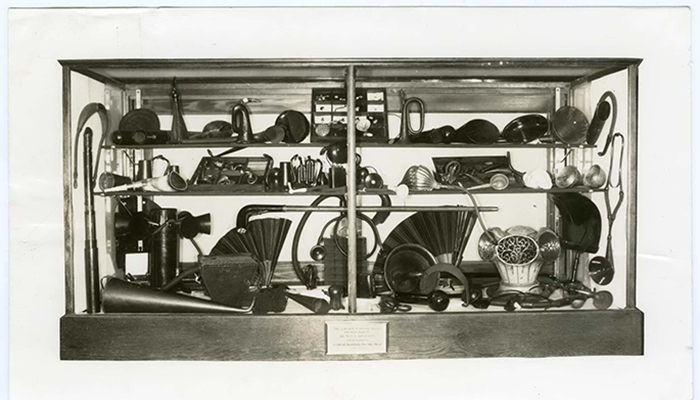
Goldstein Collection of hearing aids, including ear trumpets, at the Central Institute for the Deaf, St. Louis, Missouri, December 1935. (NCP 1313)
Prolonged exposure to loud noises can cause temporary hearing issues like tinnitus (hearing sound when none is present) or temporary to permanent hearing loss. Any form of temporary or permanent hearing loss can cause communication impairment. While noise remains a prevalent public health problem for civilians with an estimated 466 million people being affected by hearing loss according to the World Health Organization, hearing disabilities in military populations are even greater. According to the Veterans Benefits Administration, tinnitus and hearing loss are the top two service-related disabilities for service members.
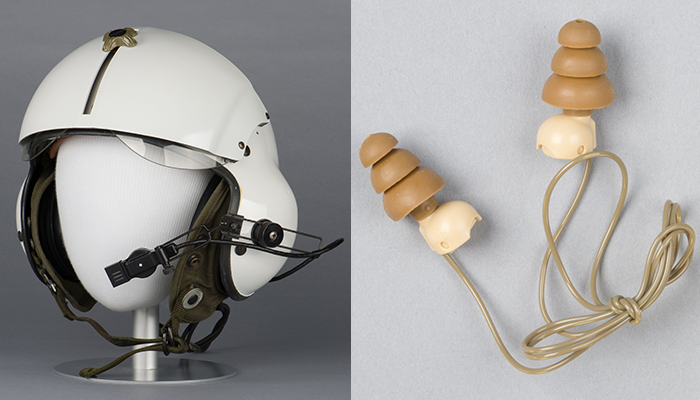
Left: SPH-4 helmet (ca. 1970) was designed for aircrew head protection that consists of an outer shell of white plastic, Styrofoam padding fitted with an olive drab component for the wearer's comfort. [NMHM 2015.0011.1] Right: Combat Arms tactical hearing protection ear plugs (ca. 2016) are designed with a series of baffles for greater attenuation of sound waves. [NMHM 2017.0009.4] (Disclosure: These images have been cropped to emphasize the subject.)(180213-D-MP902-0013/180207-D-MP902-0037: National Museum of Health and Medicine photos by Matthew Breitbart/ Released)
In a study done by the Occupational Safety and Health Administration, the sound level for an eight-hour work day should not exceed 90 decibels, the equivalent of shouting or lawn mower noise. Service members in close proximity to weapons are averaging a peak sound range of 150 to 184 decibels, the equivalent of hearing fireworks from one meter away.
Modern initiatives to combat the intense auditory conditions for service members are being developed. In 1970, the U.S. Army introduced the SPH aviation helmet which featured noise reduction baffles over the ears to minimize hearing loss. This and other important developments, such as Tactical Communication and Protective System (TCAPS) devices like Combat Arms earplugs, represent preventive measures the military has taken to reduce hearing injury.
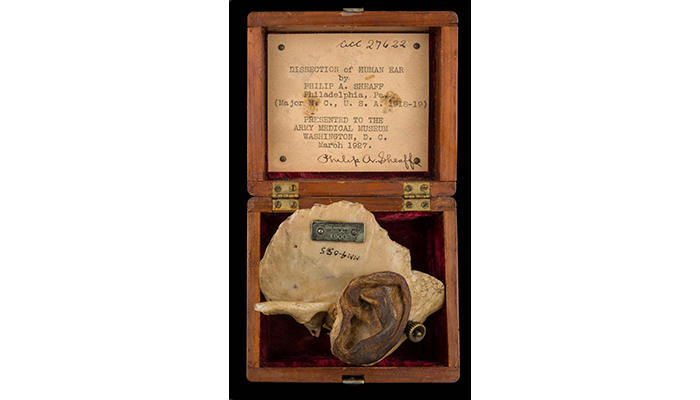
Left temporal bone and preserved outer ear. Produced and donated by Major Philip A. Sheaff, Medical Corps, U.S. Army, 1918-1919. Shows relation between the mastoid cells and middle ear. (AFIP 27622) (Disclosure: This image has been manipulated using dodging and burning techniques. It has been cropped to emphasize the subject.) (180212-D-MP902-0016: National Museum of Health and Medicine photo illustration by Matthew Breitbart/Released)
Better Hearing and Speech Month recalls the military's role in the history of research and development of audiology and speech rehabilitation.
As early as 1900, military researchers examined aural anatomy to address diseases. Maj. Philip A. Sheaff, Medical Corps, U.S. Army, dissected the temporal bone and outer ear (see photo above) to understand the relationship between the mastoid cells and the middle ear where bacterial infections can occur.
In the mid-1950s, Walter Reed General Hospital (now Walter Reed National Military Medical Center) facilitated programs for aural and speech rehabilitation. The Aural Rehabilitation Program for the Deafened at Walter Reed was proposed in 1947 for military personnel suffering from hearing loss they acquired during active military service. Similarly, the Army's Audiology and Speech Correction Program for the Deafened was initiated in 1951 and provided treatment for aural and speech therapy. This treatment is still ongoing at the renamed National Military Audiology and Speech Pathology Center.
Highlighting the history of hearing health in military medicine each May, NMHM presents historical hearing-related artifacts from the Otis Historical Archives, the Anatomical Collections, and the Historical Collections in the lab window. "In the Lab" allows a glimpse into the chronology of prevention, diagnosis, mitigation, treatment, rehabilitation, and research of hearing loss and auditory injury. Current research about hearing health in the military is being done by the Department of Defense Hearing Center of Excellence. The DoD Hearing Center of Excellence is devoted to fostering and promoting the development of new measures to reduce the prevalence and cost of hearing loss among service members.
Resources
Relevant Links:
Impact of Noise on Hearing in the Military
https://www.ncbi.nlm.nih.gov/pmc/articles/PMC4455974/
May is Better Speech and Hearing Month
https://www.army.mil/article/187325/may_is_better_speech_and_hearing_month
Noise Induced Hearing Loss
https://www.nidcd.nih.gov/health/noise-induced-hearing-loss



